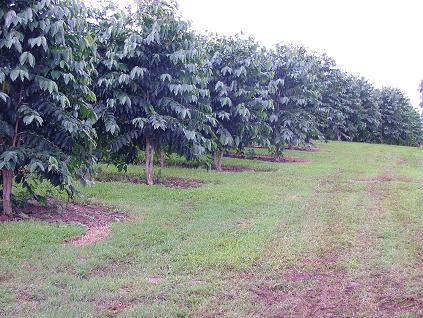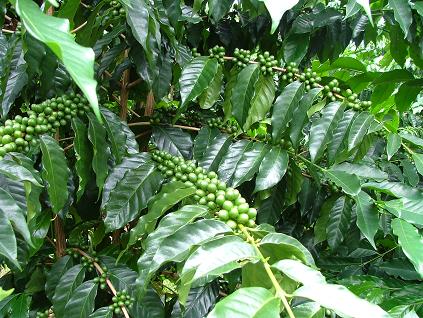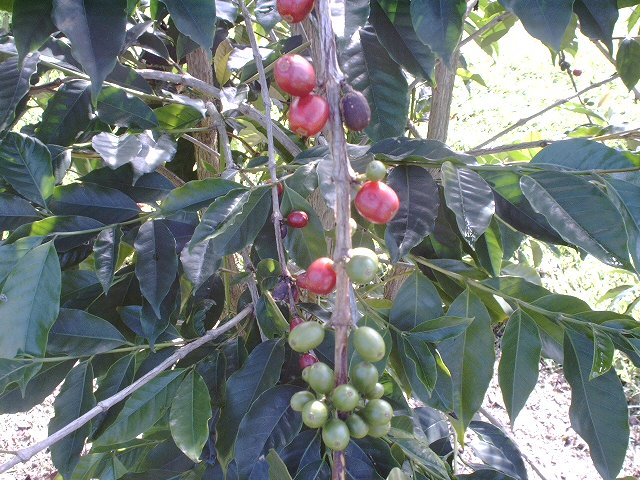Coffee and Tea

Buy 100% Pure Ground Hawaiian Kona Coffee Beans. Other Blends Available include: Kau, Puna and Green Coffee from Aloha Hawaiian Flowers and Gifts
Interview with a Coffee Grower: Where does Hawaiian Coffee come from, how is it produced, and why is it so special?
 Many of you asked
this question, so here is one Kona Coffee grower's answer:
Many of you asked
this question, so here is one Kona Coffee grower's answer:
In the spring time, the coffee trees begin to bloom. The horizontal branches are growing, from every segment comes another group of blossoms and the limb continues to grow during this spring time. In the summer these blossoms turn into coffee beans. During this time, of course, you’re doing a lot of fertilizing because you want to keep the trees happy. You need to put energies into the trees because sometimes there’s not enough nutrition in the ground.
So in late summer,
early fall, depending on your elevation, the clusters of coffee beans
begin to ripen. I’m at 1800 ft elevation so my coffee tends to
ripen later so I get my first picking around the second week of
September. What happens when you go in to pick is that this cluster
of coffee on the limb will have a variety of shades and color. There
would be the dark green, which are the mature, but not ripe, and then
they go to a light green, like your eyes, and then to a yellow and an
orange and then to a red and that’s when you pick them. In this
one cluster that may have 6- 12 berries on it, you may only pick one
or two. The other berries in the cluster may not be ripe. So you come
back every 7 to 10 days to pick again.
Aloha Hawaiian Flowers and Gifts have a variety of 100% Pure Hawaiian Coffee and Tea to choose from:
Us: And these have to be all hand picked, right?
 Grower: All hand
picked. Yes. It’s a lot of work. In fact, when you pick a pound
of a coffee cherry, it takes 110 of those to make one pound of coffee
cherry. When the pickers pick one pound, they fill up their burlap
bag, and it will weigh about 100 pounds. This season they earned 50
cents a pound. So now you have this red coffee, the cherry, and you
have to process it.
Grower: All hand
picked. Yes. It’s a lot of work. In fact, when you pick a pound
of a coffee cherry, it takes 110 of those to make one pound of coffee
cherry. When the pickers pick one pound, they fill up their burlap
bag, and it will weigh about 100 pounds. This season they earned 50
cents a pound. So now you have this red coffee, the cherry, and you
have to process it.
 The first step in the
processing is to remove the skin. The coffee is also soaked for a
period of time.
The first step in the
processing is to remove the skin. The coffee is also soaked for a
period of time.
Us: Soaked in water? How long does it take for it to ferment?
Grower: Yes, soaked in
water. It doesn’t take very long. Maybe 8 -12 hours. Then the
coffee is laid out to dry in two ways. The old, preferred way is open
air drying.  The beans remain in the sun and the air and they’re
raked quite often to turn them over. You want the beans to be dried
down to a 13% moisture content. Once that’s done, now you have
parchment coffee. And parchment coffee is dried coffee with a thin
skin on it and this skin has to be removed through milling. Once the
milling is done, now you have green coffee. Now that the coffee is
milled down to the green coffee it can be roasted.
The beans remain in the sun and the air and they’re
raked quite often to turn them over. You want the beans to be dried
down to a 13% moisture content. Once that’s done, now you have
parchment coffee. And parchment coffee is dried coffee with a thin
skin on it and this skin has to be removed through milling. Once the
milling is done, now you have green coffee. Now that the coffee is
milled down to the green coffee it can be roasted.
There’s a hot air roaster where they can put a lot of coffee in it and the roaster is controlled for temperature and they gauge it by aroma and by sight. There’s a lot that goes into it.
 The old way is the old
probat. It’s like a clothes dryer drum with an open flame under
it. That takes a lot more attention. Now I have mine roasted to a
dark roast, but I have to dump it out before the roasting process
burns off all the oil on the outside of the bean. My beans are dark
and oily. It doesn’t add to the caffeine because the darker the
roast, the less the caffeine you get. Kona coffee is less naturally
caffeinated than other coffees, by the way.
The old way is the old
probat. It’s like a clothes dryer drum with an open flame under
it. That takes a lot more attention. Now I have mine roasted to a
dark roast, but I have to dump it out before the roasting process
burns off all the oil on the outside of the bean. My beans are dark
and oily. It doesn’t add to the caffeine because the darker the
roast, the less the caffeine you get. Kona coffee is less naturally
caffeinated than other coffees, by the way.
So now you’ve gone through all the spring, summer and fall and picking. Once the picking is all done, you have to do the pruning, just as you would with grape vines. Coffee trees, like grapes, will only bloom on new wood. So you go in and you prune selectively. You take off the oldest growth and you have new wood coming up. The wood left on the tree is going to be production for this year and then the new growth that’s coming up is going to be production for the following year. In this way you always have production. I understand that the coffee trees on this island are close to 100 years old and still producing.
Like drinking tea or wine, drinking coffee is a very individual thing. And there’s a noticeable difference in the coffee grown in Kona and on the other side of the island or on the other islands. The Big Island is not the only island that grows coffee, but only Kona coffee comes from the Big Island and only Kona coffee comes from the Kona belt, a strip of land 20 miles land, with 500-2,000 feet elevation.
Us: Some people can have a percentage of Kona coffee mixed in with other coffees and they try to call it Kona, but it’s not 100% Kona. Is that true?
Grower: You might find what you call a Kona Blend. By law you have to have a minimum of 10% Kona Coffee in it. But if you put 10% Kona coffee in with 90% other stuff, you’ll never taste the Kona.
Us: But people taste that and they think its Kona coffee.
Grower: That’s one of the issues that some of the coffee organizations are trying to resolve with the state legislature. We want more truth in advertising on the coffee packages. When tourists come to Hawaii and they go to some place and see a bag of Kona coffee that’s $30 per lb and a Kona Blend for $10 per bag, of course they’re going to go for the $10 bag. But they are getting a Kona Blend and not 100% Kona Coffee.
Us: Thank you for the interview! Now we know why our 100% Kona Coffee is so popular!
At Aloha Hawaiian Flowers and Gifts, our coffee is all 100% Hawaiian Coffee, and each type of coffee is 100% that type, so for example, when you order Kona Coffee you know you are getting 100% Kona Coffee, not a blend. Our Kau and Kauai coffees are also 100% pure. We use local farmers who grow our coffee beans right here on the islands for us, roast it up guaranteed fresh just for you, package it up and send it off to you with our Aloha and Mahalo (love and gratitude). Thank you for supporting our local coffee growers. We know you will love that fresh cup of Hawaiian coffee down to the very last sip!



